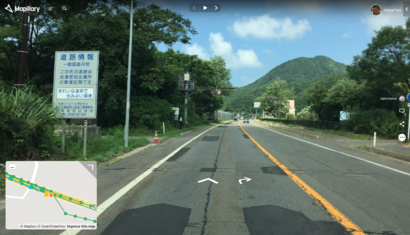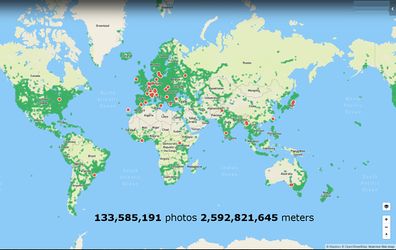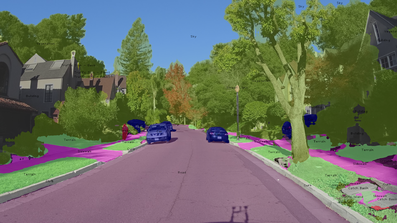JA:Mapillary
| Mapillary | ||||||||||||||||||||
|---|---|---|---|---|---|---|---|---|---|---|---|---|---|---|---|---|---|---|---|---|
| 作者: | Facebook Inc. | |||||||||||||||||||
| ライセンス: | CC-BY-SA (画像) および proprietary (webとアプリ) (無償) | |||||||||||||||||||
| 動作環境: | Android、 iOS および Windows Phone | |||||||||||||||||||
| 版数: | 3.129 (Android), 4.4.13 (iOS), 1.2.0.0 (Windows Phone) (2016-09-23) | |||||||||||||||||||
| 言語: | 日本語
| |||||||||||||||||||
| ウェブサイト: | https://www.mapillary.com/ | |||||||||||||||||||
| インストール: | ||||||||||||||||||||
|
道路の画像の収集 |
||||||||||||||||||||
| ||||||||||||||||||||


Mapillary (mapillary.com) はジオタグ付きの写真を共有するサービスです。スウェーデンのマルメにあるスタートアップが開発しましたが、2020年6月にFacebookへ売却されました。[2] そのクリエイターは(道路だけでなく)世界全体を写真で表現したいと考えています。[3][4] 世界中の興味深い場所をカバーするには、独立した、集合知によるプロジェクトと系統的な方法が必要だと彼らは信じています。カメラを備えた特別装備の自動車を持つGoogleのようなサービスは、世界中をその詳細に至るまでカバーすることはできないでしょう。[3] 彼らによれば、たいていの場合ローカルナレッジこそが最強で、写真を撮影する上で何が本当に重要なのかを現地の人々が知っています。[3] 彼らは屋外のあらゆる場所をカバーすることに興味を持っており、これは世界中を高精細レベルで表現するシステムに貢献できます。たいていの画像処理の「インテリジェンス」はサーバ側でビッグデータ技術とコンピュータビジョンを使って処理されるため、ユーザにとってはデータ収集はとても簡単です。その結果、Mapillary は個々の新しい写真が追加される度に改善されるでしょう。なぜなら全ての新しい写真は、その近くで撮られた全ての既存の写真と連携されるからです。技術的な概要についてはここ[5] に短いプレゼンテーションがあります。 データの利用者が、自分たちの興味のある地域で自分たちでカバー率を増やすことができる、というアイデアです。[3]Mapillary の開発者は、市場の中で、中立的で独立した写真を提供することに存在意義があると信じています。 [3][4]
こういった活動に貢献したい人はWindowsPhoneやAndroid あるいは iPhoneといったところからインストールすることが可能で、JollaやBlackberry のデバイスといったところからもAndroidアプリが動作したというレポートが次々に上がって来ています。ユーザ登録をしたら、ユーザは写真を撮り始めることができます。
開発者向けリソースでは、組み込み可能なウィジェットを含めJSON API がドキュメント化されています。
Mapillary のサンプル
- Mapillary フロントページのrecent uploads セクション
- map Map your town
- Show the way
- パノラマビューの共有
- Map a place
- take surveys of construction sites
- import SLR images with GPS
- 古図画像アップロードとアーカイブ
Mapillary のワークフロー
OSM参加者(OSMer)は、いくつかの点でMapillaryに貢献することができます。最もよくあるのは、AndroidとiOS用に開発されたMapillaryアプリをスマートフォンで利用するという方法です。オープンソースのWindowsアプリもあります。他にもカメラ等の装置もGPS情報が付帯して記録されているならば使えます。アプリの外で撮った写真は、Mapillaryのアップローダーや、そのスクリプトを使って投稿することができます。
コンピュータビジョン
Mapillary uses computer vision to recognize map features (objects) from the images, ranging from traffic signs to more experimental object and line recognition. The experimental features are based on semantic segmentation.
While serving as a useful visual aid for OSM editing, Mapillary also processes photos contributed using computer vision. Every photo is processed with identified faces and license plates blurred.
道路標識の自動認識
Traffic signs convey important information about road restrictions and junction layouts, and are mapped on OpenStreetMap using the traffic_Sign key.
Mapillary first introduced automatic traffic sign recognition in January 2015, and about a month later launched a system for manual validation of these recognition results, in the form of a game. This feedback led to improved automated recognition results, which were further improved by using country-specific models, and later worldwide appearance groups to cover more countries using a single model. These appearance groups are documented here. A full list of supported countries can be found here.
The recognized signs are available as a data layer within the iD editor, which can be used to assist in editing the map. The data layer contains precise locations and types of traffic signs.
セマンティックセグメンテーション

Mapillary has also started processing photos to understand the scene and a wider variety of objects within it at pixel level. This is achieved using deep learning which teaches the computer to identify scenes and objects, by comparing them to existing scenes and objects the computer has been shown. This led to the creation of the Mapillary Vistas dataset which includes 25,000 human annotated images which can be used to improve these algorithms. This data is not yet available in OSM editors but can be used when contributing to OSM.
As of August 2018, Mapillary has moved this feature to "beta". It provides an online interface for exploring recognized features, e.g. crosswalks, barriers, and traffic lights (full list). Unlike traffic signs, these features do not have their precise location determined by triangulation. Some "linear" features such as sidewalks are additionally matched against the OSM road map to generate line features, although these are usually not useful for mapping.
OSM エディタでの利用
OSM エディタで編集しているときに、 Mapillary の写真を直接簡単に利用することができます。(#ライセンスも参照)。
- iD では、「地図データ」設定内に「写真の重ね合わせ(Mapillary)」があります(Mapillary に対応している場所にいるのであれば、黄色い写真マーカーが表示されます)。 iD における Mapillary の使い方については、こちらにビデオチュートリアルがあります。
- JOSM plugin for Mapillary があり、こちらに付属のビデオチュートリアルがあります。
- Pic4Review, an easy editor for OSM using street-level pictures, heavily uses Mapillary pictures.
- https://osm.cycle.travel/deriviste/, an tool to insert nodes with tags by moving markers on Mapillary photos.
OSM コミュニティへの支援活動
Mapillary は、 SotM conferences、 Maptime meetup、 人道支援プロジェクトなどを含む OSM イニシアティブの範囲に対応しています。 Through a partnership with Humanitarian OpenStreetMap, Mapillary provides equipment and technical support for projects that are actively contributing OpenStreetMap. あなたの活動の何を支援できるのかは、Mapillary を見てください。
電話を車に装着するためのマウントは、OSMで編集したいエリアの写真を撮るのに役立てるために、無料で提供されます。
カーマウントキットについての詳細、自転車への搭載、バッテリーパックについてはこちらにあります。詳しくはこちらを参照してください。
ライセンス
Mapillary 上の画像はCreative Commons Attribution-ShareAlike 4.0 International License (CC-BY-SA)の下で利用することができます。[6] OpenStreetMap に投稿するために写真からデータを取り出すためには特別な許可を得ています。GPXトラックは無制限に利用可能です。
ライセンスは2014年4月29日に、CC-BY-NC からCC-BY-SA へ変更されました。[7]
By using Mapillary contributors also grant Mapillary a worldwide, perpetual, and transferable license to use the photos and other content for commercial purposes. [6]
関連項目
mapillary=*- Associate a Mapillary picture to an OSM feature.- Photo linking - Create links between OSM features and external pictures
- KartaView
- Mapillary/Data collection of 360 degree images with Mapillary - Description of a 360 ° image capture method with an on-board camera.
出典
- ↑ Katie Paul: Facebook acquires crowdsourced mapping company Mapillary. Reuters, 2020-06-18 online
- ↑ Archived blog post by Jan Erik Solem (CEO and co-founder of Mapillary)
- ↑ 3.0 3.1 3.2 3.3 3.4 Welcome to Mapillary! (en), by Jan Erik Solem. Posted on 1 Jan 2014.
- ↑ 4.0 4.1 Mapillary Manifesto (en), by Jan Erik, Johan, Peter and Yubin (a.k.a the Mapillary team).
- ↑ Technical Overview (en) by Peter Neubauer
- ↑ 6.0 6.1 legal page
- ↑ [1]
